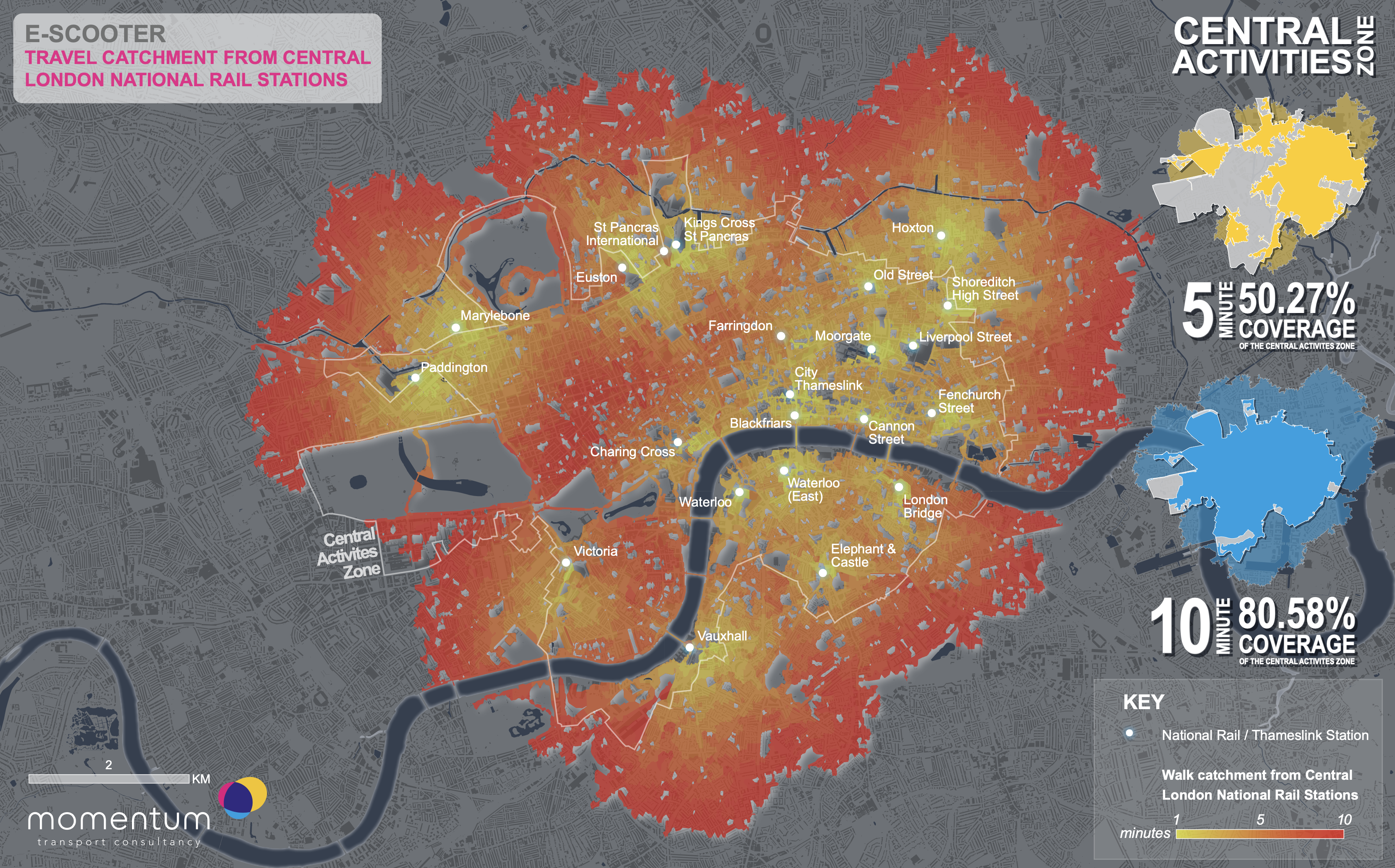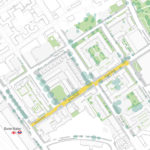Click to view our map visualisation: Showing the travel catchment from Central London national rail stations
But what is their potential?
E-scooters – everyone has an opinion on them. These opinions might have changed based on your experience of them so far, either from your memories of gliding along the Barcelona waterfront promenade or from that time you were nearly knocked off your feet by one crossing Oxford Circus. The UK’s stance on these micro-modes has been clear – they’re banned, but, following a call for increased transport options, we can now expect to see some shared-system scooters (perhaps by Lime, Bird, Voi etc) weaving around our streets in the very near future.
Previously promoted as an (arguably) sustainable first and last-mile solution and complimentary to public transport, the need for these vehicles has somewhat changed in the last couple of months. Suddenly, our attention moves from reducing transport-related carbon emissions to providing workers with a mode which allows them to remain socially distanced yet able to make journeys which they would normally use public transport for. In London, it is difficult for us to imagine squeezing ourselves onto a packed tube again, at least not any time soon. The UK government has taken a big and bold step forward by moving the original 2021 e-scooter trial period to June 2020 onwards. In the transport industry, countless webinars, roundtables and consultations are taking place to gather viewpoints surrounding this ‘new’ transport mode. Of course, safety remains absolute priority, but the opportunity for people to move independently, particularly in a city such as London is crucial.
So, what potential do they have? Do they actually solve a problem?
They say a picture is worth a thousand words, well, we think the same about the below map. At the moment, we’re still avoiding trains but once more movement is permitted and train travel is required, it’s anticipated at least some Londoners will do whatever it takes to avoid using the tube to travel to their final destination. Based on an average speed of 16kmph, we’ve plotted the distance an e-scooter rider might be able to travel in just 10 minutes from Zone 1, central London train stations. The potential for e-scooters to reduce over-crowding on the London Underground is clear.
Cartography by James O’Brien
But what about active travel?
Of course, many of these journeys can be walked (a third of the speed) or cycled, though the convenience of an e-scooter is potentially attractive to the masses.
Moving people from tube to scooter could also encourage future active travel as confidence in moving about the streets increases. Potentially, e-scooters provide that stepping-stone from polluting car use and over-capacity public transport towards the sunnier realms of active travel.
Facilitating their usage
To facilitate the use of e-scooters and other micromobility methods, there is an utmost need to make streets safer spaces than they are at present.
Recently, the Department for Transport announced an ‘Emergency Active Travel Fund’, made available to all local authorities in England. This fund has been developed based on the proportion of adults in each local authority who travel to work via public transport – with the emphasis that some of these trips could otherwise go to private cars. Micromobility and associated measures provide a good alternative to private car use under these circumstances. Our next hope is that local authorities apply for the funding and utilise it effectively!
Indeed, several London boroughs and other local authorities have been successful in their applications for funding and have already been consulting on local schemes. Some are promoting schemes known as ‘low traffic neighbourhoods’ where, via the usage of temporary modal filters, vehicle access will be reduced to residential areas in an effort to promote travel by other means. For example, the London Borough of Southwark is looking to implement low traffic neighbourhoods across Walworth and Kennington. These schemes are both aiming to provide cycling lanes and widened footpaths, facilitating e-scooter travel. To see what each local authority is doing, search for the name of your council along with ‘Streetspace Schemes’.
Of course, e-scooter trials only permit the use of shared e-scooters however one must give thought to privately-owned scooters. Similar to bicycles, where will they be parked, charged and stored? Perhaps it’s time for developments, offices in particular, to look past the bicycle and provide space for e-scooter users. But should they stop there? Are we at a cusp of a micromobility revolution in the UK? Will other micro-modes start entering the market?
Looking forward
It is absolutely imperative that each rider AND driver takes responsibility for the way they use the roads to keep them safe for everyone. Above all, pedestrians must sit at the top of the hierarchy – streetspace is their space and e-scooters must not disrupt that. As we pull away from the depths of the pandemic and the primary use of e-scooters moves back towards being a first and last-mile solution, urban designers, policy-makers, technologists and road users will need to adapt to ensure that we continue to make the most of the mode, both for society and for sustainability. We should look to the future, envisage what we want and set out to get it.








